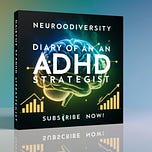In the quiet library corner, with her laptop open and notes spread around her, Mia stares blankly at her screen.
She looks focused from the outside. But inside her mind, fifteen different thoughts are competing for attention, none related to her research paper due tomorrow.
She craves the solitude this corner provides—as an introvert, she needs this quiet space to recharge.
Yet her brain refuses to cooperate, buzzing with internal hyperactivity that makes true relaxation impossible. This internal conflict is her daily reality as someone with both ADHD and introversion.
Many people assume ADHD always looks like the stereotypical hyperactive child bouncing off the walls.
But for millions of introverts with ADHD, the experience is dramatically different—their hyperactivity manifests internally as racing thoughts, making the introvert's need for mental quiet particularly challenging to achieve peace.
the experience is dramatically different
Breaking It Down: What's This All About?
The unique intersection of ADHD and introversion creates a cognitive profile that's often misunderstood or completely overlooked. While these two traits might seem contradictory at first glance, they actually coexist in many individuals, creating both unique challenges and surprising strengths.
ADHD (Attention-Deficit/Hyperactivity Disorder) is a neurodevelopmental condition characterized by persistent patterns of inattention, hyperactivity, and impulsivity that significantly impair functioning in daily life. Introversion, meanwhile, describes a personality trait where individuals primarily direct their energy inward, finding solitude and reflection more restorative than external stimulation and social engagement.
When these traits combine, the result is not simply the sum of both parts but a complex interaction that shapes a person's entire experience of the world.
creating both unique challenges and surprising strengths
Why This Matters?
Understanding this intersection matters because introverts with ADHD often feel deeply misunderstood, with their struggles frequently overlooked or dismissed. They may appear calm and quiet externally while experiencing intense internal restlessness that others cannot see clearly.
For those experiencing this combination of traits, the recognition that their challenges are real and shared by others can be incredibly validating. Many report feeling profound relief upon learning that their seemingly contradictory experiences make perfect sense when viewed through this dual lens.
For families, educators, employers, and healthcare providers, recognizing how ADHD manifests differently in introverts is crucial for providing appropriate support, accommodations, and treatment strategies that actually work.
their challenges are real and shared by others
The Science Behind It
Research increasingly shows that the co-occurrence of ADHD and introverted traits is more common than previously thought. Multiple studies indicate that a significant percentage of individuals with ADHD also exhibit introverted tendencies, challenging the stereotype of ADHD as primarily an extroverted condition.
The neurological underpinnings of both traits help explain this complex interaction. ADHD involves differences in brain structure and function, particularly in regions like the prefrontal cortex, which plays a crucial role in executive functions such as attention and organization. Neurotransmitter systems, specifically dopamine and norepinephrine, are also implicated in ADHD, affecting attention, motivation, and impulse control.
Introversion also has neurological foundations, with introverts showing different patterns of brain activity and neurotransmitter processing. They may have a lower threshold for dopamine sensitivity, leading to quicker overstimulation in response to external rewards. They also tend to have higher baseline levels of cortical arousal, making them more sensitive to external stimuli. The neurotransmitter acetylcholine plays a significant role in the feelings of pleasure and well-being that introverts experience during calm, introspective activities.
When these neurological profiles combine, the result is a brain that's both highly sensitive to stimulation and has difficulty filtering irrelevant inputs, creating a perfect storm for sensory and mental overload.
individuals with ADHD also exhibit introverted tendencies
Making It Work: How to Apply This in Real Life
Here are practical strategies for navigating life as an introvert with ADHD or supporting someone who is:
✅ Step 1: Create a Sanctuary –
Establish a quiet, low-distraction workspace tailored to your needs. Use noise-canceling headphones, minimize visual clutter, and set clear boundaries around your space. Having a dedicated area where sensory input is controlled helps manage the dual challenges of ADHD distractibility and introverted sensitivity to external stimulation.
✅ Step 2: Master Energy Management –
Recognize that both ADHD and introversion affect your energy levels in different ways. Schedule regular alone time for recharging, build breaks into your day, and learn to recognize early signs of overload before reaching complete exhaustion. The "introvert hangover" can be particularly intense when combined with ADHD-related mental fatigue, so preventative energy management is absolutely essential here.
✅ Step 3: Leverage Hyperfocus Strategically –
Identify when your ADHD hyperfocus aligns with your introverted depth of thought, and create conditions to harness this powerful combination. Set aside dedicated time blocks for deep work on meaningful projects, minimize interruptions during these periods, and use visual cues to track time so you don't get completely lost in your flow.
✅ Step 4: Develop Social Strategies –
Create a social approach that honors both your introversion and ADHD needs. This might include preparing for social events by researching topics beforehand, scheduling shorter interactions with breaks, and having exit strategies ready when you feel overwhelmed. Remember that you'll need more downtime than either typical introverts or extroverts with ADHD to process social interactions and recover fully.
✅ Step 5: Embrace Internal Awareness –
Learn to distinguish between productive internal thinking (introverted reflection) and unproductive mental noise (ADHD-related racing thoughts). Meditation, mindfulness, and journaling can help you develop this awareness and create more mental space even when your thoughts are moving quickly.
Real-Life Examples in Action
Consider Marcus, a software developer who thrives when working remotely. His manager initially misinterpreted his quiet demeanor and occasional difficulty following group conversations as disinterest or lack of engagement. In reality, Marcus was constantly processing multiple streams of thought while also expending significant energy managing social interactions in the office environment.
When the pandemic forced remote work, Marcus flourished. He could structure his environment to minimize distractions, take short breaks without judgment when he needed to reset his focus, and communicate through writing, which gave him time to organize his often brilliant but scattered thoughts. His productivity soared.
Another example is Eliza, a college student who struggled throughout high school but couldn't understand why. She was always drawn to quiet study environments yet found herself unable to stay on task even in the library. Her internal restlessness made it nearly impossible to focus on subjects that didn't deeply engage her natural curiosity.
After being diagnosed with ADHD at 19, Eliza developed strategies that worked with her introverted ADHD brain. She now studies in 25-minute focused sessions followed by short movement breaks, uses visualization techniques to maintain interest in less stimulating subjects, and schedules regular "mental reset" days where she can pursue her own interests deeply without interruption. Her grades improved dramatically, but more importantly, she no longer sees herself as inherently flawed for needing different conditions to work effectively.
Pro Tips & Insider Insights
🧠 The "body doubling" technique can be adapted for introverts with ADHD by working quietly alongside one trusted person rather than in group settings, providing accountability without social overwhelm.
🧠 Text-based communication often works better than verbal for introverts with ADHD, allowing time to process thoughts before responding and creating a record to reference later when working memory fails.
🧠 Stimming (self-stimulatory behavior) looks different in introverted people with ADHD—often manifesting as more subtle activities like finger tapping, hair twirling, or mental stimming through daydreaming or creating elaborate scenarios.
🧠 The transition between activities is particularly challenging for introverts with ADHD—creating a brief "buffer zone" of 5-10 minutes between commitments can dramatically reduce stress and improve functioning.
🧠 Many introverts with ADHD report that "thinking out loud" to themselves when alone helps organize their thoughts—recording these sessions can capture valuable insights that might otherwise be lost.
Quick Cheat Sheet (Summary of Key Takeaways)
🔑 The combination of ADHD and introversion creates unique challenges and strengths that differ from either trait in isolation.
🔑 Internal hyperactivity (racing thoughts) rather than external hyperactivity is a common manifestation in introverts with ADHD.
🔑 Sensory sensitivity is often heightened when both conditions are present, requiring more careful management of environmental input and stimulation.
🔑 Hyperfocus combined with introverted depth can result in exceptional creative output and problem-solving when properly channeled and directed.
🔑 Social exhaustion can be more pronounced and require longer recovery periods than for typical introverts or extroverts.
🔑 Customized strategies that address both sets of needs are essential for optimal functioning and mental wellbeing.
Further Reading (Books & Resources)
📖 Quiet: The Power of Introverts in a World That Can't Stop Talking by Susan Cain
📖 Taking Charge of Adult ADHD by Russell A. Barkley
📖 Divergent Mind: Thriving in a World That Wasn't Designed For You by Jenara Nerenberg
📖 Your Life Can Be Better: Using Strategies for Adult ADD/ADHD by Douglas A. Puryear
Practical Tools & Apps
🔧 Forest App – Uses the Pomodoro technique with a visual tree-growing component that appeals to both the ADHD need for immediate rewards and the introvert's appreciation of quiet growth.
🔧 Notion – Highly customizable organization system that allows for both detailed planning (helpful for ADHD) and thoughtful reflection (appealing to introversion).
🔧 Brain.fm – Science-backed focus music designed to help manage distractions without being overstimulating.
🔧 Headspace – Meditation app with specific programs for both focus and quieting racing thoughts.
🔧 Habitica – Gamifies productivity in a way that can motivate the ADHD brain while not requiring social interaction.
Research & Studies Section (Citations & Sources)
American Psychiatric Association. (2013). Diagnostic and statistical manual of mental disorders (5th ed.).
Cain, S. (2012). Quiet: The power of introverts in a world that can't stop talking. Crown Publishing Group.
Barkley, R. A. (2015). Attention-deficit hyperactivity disorder: A handbook for diagnosis and treatment (4th ed.). Guilford Press.
Faraone, S. V., & Larsson, H. (2019). Genetics of attention deficit hyperactivity disorder. Molecular Psychiatry, 24(4), 562-575.
Kessler, R. C., Adler, L., Barkley, R., Biederman, J., Conners, C. K., Demler, O., ... & Zaslavsky, A. M. (2006). The prevalence and correlates of adult ADHD in the United States: results from the National Comorbidity Survey Replication. American Journal of Psychiatry, 163(4), 716-723.
Laney, M. O. (2002). The introvert advantage: How to thrive in an extrovert world. Workman Publishing.
The Intertwined Effects of ADHD and Introversion on Cognitive, Emotional, and Social Experiences" Research Report. (2024).
What Next…
If you've been nodding along while reading this article, you're not alone. The unique combination of introversion and ADHD may create challenges, but it also comes with remarkable strengths when properly understood and effectively managed.
Start by implementing just one strategy from this article this week. Notice how it affects your energy, focus, and overall wellbeing. Small adjustments can lead to significant improvements when they're aligned with your brain's actual functioning patterns.
🎧 For more insights, check out the Diary of a ADHD Strategest podcast:
If this article resonated with you, then help a friend and share it!
Also subscribe to never miss an ADHD hack to navigate your issues.
















Share this post